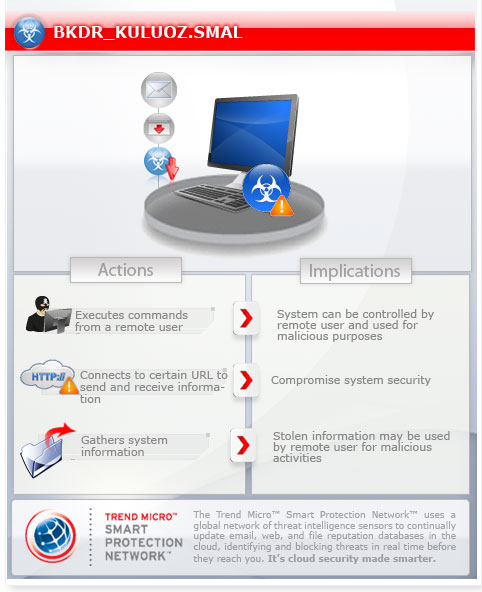BKDR_KULUOZ.SMAL
TrojanDownloader:Win32/Kuluoz.D (Microsoft); BackDoor-FBYV!ABF06238284D (McAfee), Win32/TrojanDownloader.Zortob.B (Eset)
Windows 2000, Windows Server 2003, Windows XP (32-bit, 64-bit), Windows Vista (32-bit, 64-bit), Windows 7 (32-bit, 64-bit)


Threat Type: Backdoor
Destructiveness: No
Encrypted: Yes
In the wild: Yes
OVERVIEW
Spammed via email, Downloaded from the Internet, Dropped by other malware
This malware is the attached payload of a socially-engineered malicious spam themed after the South Korea Ferry tragedy. Discovered on April 2014, it is detected to receive and execute commands from a remote malicious user. Users with systems affected with this threat may find the security of their systems compromised.
To get a one-glance comprehensive view of the behavior of this Backdoor, refer to the Threat Diagram shown below.

This backdoor arrives as an attachment to email messages spammed by other malware/grayware or malicious users. It arrives on a system as a file dropped by other malware or as a file downloaded unknowingly by users when visiting malicious sites.
It executes commands from a remote malicious user, effectively compromising the affected system. It connects to a website to send and receive information.
TECHNICAL DETAILS
234,496 bytes
EXE
Yes
17 Apr 2014
Compromises system security, Connects to URLs/IPs
Arrival Details
This backdoor arrives as an attachment to email messages spammed by other malware/grayware or malicious users.
It arrives on a system as a file dropped by other malware or as a file downloaded unknowingly by users when visiting malicious sites.
Installation
This backdoor drops the following copies of itself into the affected system:
- %Application Data%\{random}.exe
(Note: %Application Data% is the current user's Application Data folder, which is usually C:\Documents and Settings\{user name}\Application Data on Windows 2000, XP, and Server 2003, or C:\Users\{user name}\AppData\Roaming on Windows Vista and 7.)
It adds the following processes:
- svchost.exe
It adds the following mutexes to ensure that only one of its copies runs at any one time:
- 2GVWNQJz1
It injects codes into the following process(es):
- created svchost.exe
Autostart Technique
This backdoor adds the following registry entries to enable its automatic execution at every system startup:
HKEY_CURRENT_USER\Software\Microsoft\
Windows\CurrentVersion\Run
{random} = "%Application Data%\{random}.exe"
Other System Modifications
This backdoor adds the following registry entries:
HKEY_CURRENT_USER\Software\{random}
{random} = "{hex values}"
It adds the following registry keys as part of its installation routine:
HKEY_CURRENT_USER\Software\{random}
Backdoor Routine
This backdoor executes the following commands from a remote malicious user:
- Set system to idle/sleep
- Download and run/execute other files
- Remove/Uninstall itself
- Update copy of the injected code to svchost.exe
- Update copy of itself
- Check malware version and terminate execution of older version
It connects to the following websites to send and receive information:
- http://{BLOCKED}3.27:443/{generated value}
- http://{BLOCKED}5.89:8080/{generated value}
- http://{BLOCKED}.58/{generated value}
NOTES:
This backdoor checks if there's a running window with the following name:
- 99929D61-1338-48B1-9433-D42A1D94F0D2
- 99929D61-1338-48B1-9433-D42A1D94F0D2-x32
- 99929D61-1338-48B1-9433-D42A1D94F0D2-x64
- APISpy32Class
- Dumper
- Dumper64
- Iris - Version 5.59
- PROCEXPL
- PROCMON_WINDOW_CLASS
- ProcessHacker
- ProcessLasso_Notification_Class
- SharedIntApp.exe
- TSystemExplorerTrayForm.UnicodeClass
- Tfrmrpcap
- VBoxService.exe
- VBoxTray.exe
- VMwareDragDetWndClass
- VMwareSwitchUserControlClass
- WdcWindow
- iptools.exe
- prl_cc.exe
- prl_tools.exe
- vmsrvc.exe
- vmtoolsd.exe
- vmusrvc.exe
- wireshark.exe
The {generated value} is based on user name, local IP, running debugger, and malware build date and version.
It checks Service Disk or BIOS for the following registry information if under virtualization:
- VMware
- PTLTD
- Virtual
- VBOX
- AMIBI
SOLUTION
9.700
10.733.00
17 Apr 2014
Step 1
Before doing any scans, Windows XP, Windows Vista, and Windows 7 users must disable System Restore to allow full scanning of their computers.
Step 2
Scan your computer with your Trend Micro product and note files detected as BKDR_KULUOZ.SMAL
Step 3
Restart in Safe Mode
Step 4
Delete this registry value
Important: Editing the Windows Registry incorrectly can lead to irreversible system malfunction. Please do this step only if you know how or you can ask assistance from your system administrator. Else, check this Microsoft article first before modifying your computer's registry.
- In HKEY_CURRENT_USER\Software\Microsoft\Windows\CurrentVersion\Run
- {random} = "%Application Data%\{random}.exe"
- {random} = "%Application Data%\{random}.exe"
Step 5
Restart in normal mode and scan your computer with your Trend Micro product for files detected as BKDR_KULUOZ.SMAL. If the detected files have already been cleaned, deleted, or quarantined by your Trend Micro product, no further step is required. You may opt to simply delete the quarantined files. Please check this Knowledge Base page for more information.
NOTES:
The following created registry key(s) cannot be identified by the user since there are no reference values in the created key. The only way it can be identified is by comparing the present keys with a backup of the system registry. Note that the said key(s) do not have to be deleted since it won't be harmful to the system:
- HKEY_CURRENT_USER\Software\{random}
Did this description help? Tell us how we did.

